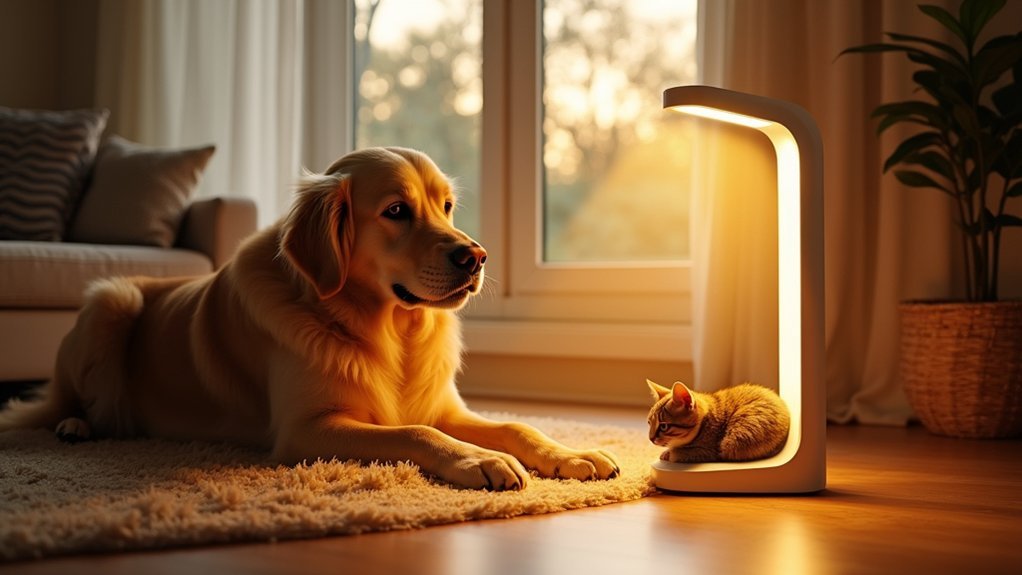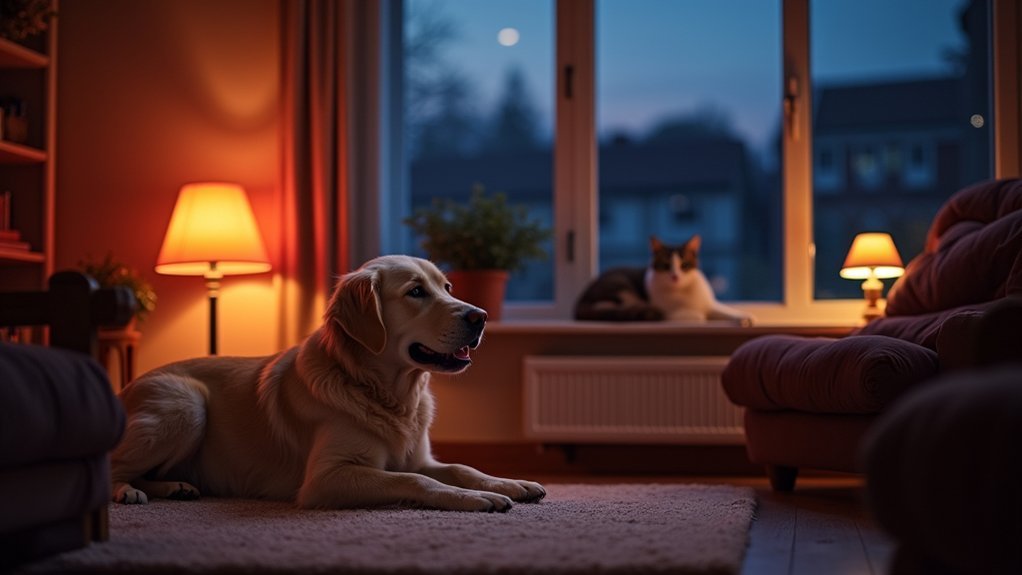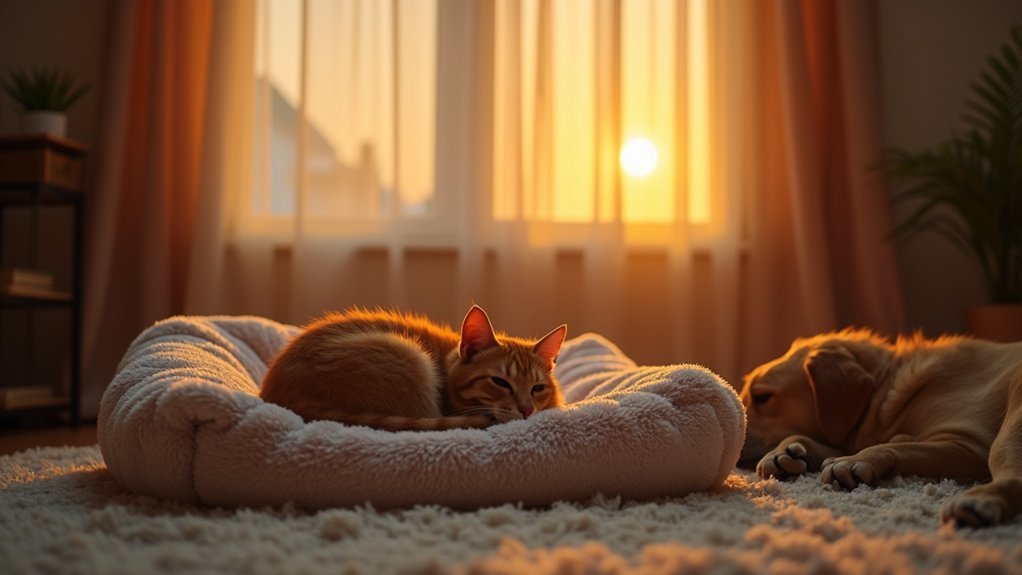Just as ancient wolves tracked the sun’s arc across primeval skies, your domesticated companions still harbor intrinsic biological rhythms. You might not realize how profoundly light impacts your pet’s physiological and psychological well-being. Circadian lighting isn’t just a design trend—it’s a science-driven approach to creating environments that support natural animal behaviors. From shelter facilities to home spaces, understanding how illumination affects your pet’s daily cycle could transform their comfort and health. Want to uncover the hidden language of light?
Key Takeaways
- Install LED light fixtures between 3500-4000 Kelvin to simulate natural daylight and support healthy circadian rhythms for pets.
- Implement gradual light transitions using dimmable fixtures to mimic natural sunrise and sunset patterns, reducing animal stress.
- Utilize red light sources during nighttime hours to maintain sleep cycles while providing minimal illumination for safety and comfort.
- Position natural light sources like Solatube Daylighting Systems to ensure consistent exposure that regulates hormone production and emotional well-being.
- Design lighting environments with consistent color temperatures that promote relaxation, reduce anxiety, and support optimal physiological functioning in pets.
Understanding Circadian Rhythms in Pets

While many pet owners may not realize it, circadian rhythms play a critical role in your pet’s physiological and psychological well-being. These natural biological cycles regulate essential functions for dogs and cats, influencing sleep-wake cycles, hormone production, and emotional health through light exposure. Natural light triggers specific neurological responses that help manage stress and maintain balanced cortisol levels, ensuring your pet remains alert and calm throughout the day.
Understanding how light impacts your pet’s internal clock can greatly improve their overall well-being. When pets receive consistent, appropriate light exposure, they experience more stable metabolic processes, reduced anxiety, and enhanced cognitive function. By supporting their circadian rhythms, you’re providing a foundation for ideal physical and mental health, helping your furry companion thrive in their daily environment.
Natural Light and Animal Well-Being

Although natural light plays a pivotal role in animal health, many pet owners underestimate its profound impact on their companion’s physiological and psychological well-being. Daylight exposure directly influences circadian rhythms, regulating critical biological processes that sustain ideal animal well-being. By modulating serotonin levels, natural light enhances emotional health and reduces anxiety, creating a more balanced internal environment for pets.
Design strategies incorporating windows and skylights can transform animal shelters, lowering cortisol levels and minimizing stress. Such interventions not only improve immune system functioning but also make sheltered animals more approachable and adoptable. Thoughtful integration of natural light represents a scientifically-backed approach to supporting thorough animal welfare, demonstrating how environmental factors fundamentally shape an animal’s physiological and psychological landscape.
Designing Pet-Friendly Lighting Environments

How can we transform lighting environments to optimize pet well-being? By designing circadian-focused lighting systems that support animals’ natural rhythms and psychological needs. Implementing strategic LED fixtures becomes essential in creating pet-friendly environments that reduce stress and enhance adoption rates.
Key considerations for designing animal-focused lighting include:
- Utilize LED fixtures between 3500-4000 Kelvin to simulate natural daylight, promoting comfort and physiological balance
- Incorporate dimming capabilities that allow adaptive brightness levels, facilitating calm shifts throughout daily cycles
- Integrate red light fixtures for nighttime illumination, maintaining natural sleep patterns while ensuring staff safety
Natural light sources like Solatube Daylighting Systems further complement these approaches, delivering thorough lighting solutions that prioritize animal welfare and environmental harmony.
Nighttime Lighting Strategies for Reduced Stress

Building upon the foundational principles of circadian-focused lighting design, nighttime illumination emerges as a critical factor in mitigating stress for shelter animals. Red light fixtures provide a strategic solution for creating a calm environment during nocturnal hours. You’ll find that these specialized lighting strategies minimize disruptions to animals’ circadian rhythms, effectively reducing anxiety and promoting healthier sleep cycles.
Color Temperature and Animal Comfort

When designing lighting environments for pets, color temperature emerges as a critical factor in promoting animal comfort and well-being. Color temperature within the 3500-4000 Kelvin range mimics natural daylight, supporting ideal circadian rhythms and reducing animal anxiety in various settings.
Key considerations for animal-friendly lighting include:
- Select lighting fixtures that provide consistent color temperatures to create a relaxed setting
- Utilize cool color temperatures that enhance animal mood and minimize stress responses
- Implement strategic lighting in adoption spaces to improve animal visibility and emotional regulation
Maintaining a scientifically informed approach to color temperature guarantees that pets experience a comfortable, naturalistic environment that supports their physiological and psychological needs. By carefully selecting lighting that reflects gentle, daylight-like qualities, you can notably contribute to animals’ overall well-being and emotional stability.
Implementing Circadian Lighting in Different Settings
The cornerstone of effective circadian lighting lies in its adaptable implementation across diverse animal environments. When designing circadian lighting solutions, you’ll want to carefully integrate LED fixtures with dimming controls to support natural light cycles. Animal shelters, veterinary clinics, and research facilities can leverage these technologies to enhance sleep quality and reduce stress for animals.
Consider using Solatube Daylighting Systems to introduce natural illumination, which reinforces biological rhythms. Nighttime lighting strategies, such as low-intensity red light fixtures, minimize sleep disturbances while maintaining staff safety. By maintaining consistent lighting environments with color temperatures between 3500-4000 Kelvin, you’ll create stable, comfortable settings that directly support animal welfare and promote ideal physiological functioning.
Frequently Asked Questions
What Color Light Is Best for Dogs to Sleep LED?
You’ll want red LED light for your dog’s sleep, as it supports natural sleep cycles, reduces stress, and maintains melatonin production without disrupting their nighttime routine or comfort in low light intensity.
What Is Wildlife Friendly Lighting?
Ironically, you’d think light’s harmless, but wildlife-friendly lighting minimizes disruption to nocturnal animals by using long-wavelength LEDs that reduce light pollution, preserve ecosystem balance, and support natural predator-prey dynamics through eco-friendly illumination solutions.
Are LED Lights Safe for Animals?
LED lights are generally safe for animals when you choose the right spectrum and intensity. They reduce stress, minimize heat emission, and support pet health by mimicking natural daylight while providing energy-efficient, stable illumination.
Is Blue Light Bad for Dogs’ Eyes?
Blue light can harm your dog’s eyes, disrupting their vision and nocturnal behavior. Different dog breeds have varying light sensitivities, so you’ll want to minimize artificial blue light exposure to protect their eye health and circadian rhythms.
Conclusion
You’ve discovered a revolutionary approach to pet care through circadian lighting. By understanding their biological rhythms, you can create environments that nurture their physical and emotional well-being. Just as a town crier would herald new technological innovations, these lighting strategies represent a quantum leap in animal welfare. Thoughtfully designed illumination isn’t just about brightness—it’s about supporting your pet’s most fundamental biological needs.
